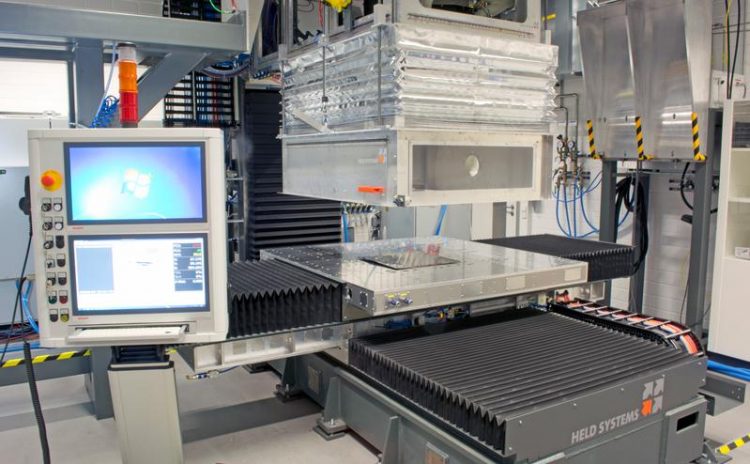“MuReA“ provides quick and large-scale laser applications

The multi remote system of the Fraunhofer IWS Dresden processes large areas by means of laser radiation and atmospheric pressure plasma. © Fraunhofer IWS Dresden
Fraunhofer IWS engineers developed and designed a novel multi remote system, which is available for basic research tests and for further projects. The combination of height-adjustable high performance scanners with a movable cross table enables the engineers to process complex compounds in a flexible and large-scale manner.
The “MuReA” provides laser sources within the kilowatt power range of one micrometer and 10.6 micrometers. The beam sources can be used in a single as well as in a simultaneous mode. In addition, the Fraunhofer IWS Dresden designed the scanner and the machine table control in such a way that also continuous materials such as tissue, metal or organo sheet can be processed.
In this way, laser processes such as joining, cutting or ablation can be efficiently developed and be transferred into industrial applications. The spectrum of offers ranges from small series production to system configuration up to the adaption of system components for industrial purposes.
Consumer demand determines development
The development’s backdrop is the increasing demand for more efficient laser systems. Lightweight construction for sheet-like semi-finished products consisting of various materials, requires flexible production and processing technologies.
“In particular, automotive and aerospace industries demand machine systems, which achieve processing speeds of up to 100 meters per minute,” explains Annett Klotzbach, group manager “Bonding and Composite Technologies” at the Fraunhofer IWS Dresden. “Our solution approach consists of laser remote processes with beam sources, which are adapted to material and absorption properties.”
Two tiltable mirrors deflect the laser beam to the component and focus it with focal lengths of 200 up to 1000 millimeters. Even very small mirror deflections result in laser spot motion speeds of up to ten meters per second.
Safe, clean and activated
During the process of laser material ablation, cutting or structuring of carbon fiber reinforced polymers (CRFP) or stainless steel, hazardous particles or vapors emerge, which might damage electric as well as mechanical components of the system.
This is the reason why the IWS project team optimized the encapsulation of the electronics and additionally implemented a suction chamber. This chamber efficiently removes by-products from a working space (comprising about one cubic meter) and subsequently filters them out by means of particular filtering equipment.
For the task of the adhesive bonding of titanium and aluminum with fiber composite material the IWS team could clearly prove that a laser processing improves adhesive strength and aging stability. In this process the surface is cleaned and the oxide layer is positively influenced. Since a processing with atmospheric pressure plasma chemically activates the surface and improves the adhesion of different materials, the IWS team additionally implemented double rotary nozzles into the system. Thus a sequential and simultaneous material processing by means of plasma and laser becomes possible.
Come and visit us at the “Composites Europe” tradeshow in Stuttgart from September 19 to 21, 2017 in hall 4, booth D40 and at the tradeshow “Schweißen und Schneiden“in Düsseldorf from September 25 to 29, 2017 in hall 15, booth 15D23.
Contact:
Fraunhofer-Institut für Werkstoff- und Strahltechnik IWS Dresden
01277 Dresden, Winterbergstr. 28
Germany
Annett Klotzbach
Phone: +49 351 83391 3235
Fax: +49 351 83391 3300
E-Mail: annett.klotzbach@iws.fraunhofer.de
Public Relations
Dr. Ralf Jäckel
Phone: +49 351 83391-3444
Fax: +49 351 83391-3300
E-Mail: ralf.jaeckel@iws.fraunhofer.de
https://www.iws.fraunhofer.de/en/pressandmedia/press_releases/2017/press_release…
Media Contact
All latest news from the category: Materials Sciences
Materials management deals with the research, development, manufacturing and processing of raw and industrial materials. Key aspects here are biological and medical issues, which play an increasingly important role in this field.
innovations-report offers in-depth articles related to the development and application of materials and the structure and properties of new materials.
Newest articles

NASA: Mystery of life’s handedness deepens
The mystery of why life uses molecules with specific orientations has deepened with a NASA-funded discovery that RNA — a key molecule thought to have potentially held the instructions for…

What are the effects of historic lithium mining on water quality?
Study reveals low levels of common contaminants but high levels of other elements in waters associated with an abandoned lithium mine. Lithium ore and mining waste from a historic lithium…

Quantum-inspired design boosts efficiency of heat-to-electricity conversion
Rice engineers take unconventional route to improving thermophotovoltaic systems. Researchers at Rice University have found a new way to improve a key element of thermophotovoltaic (TPV) systems, which convert heat…



